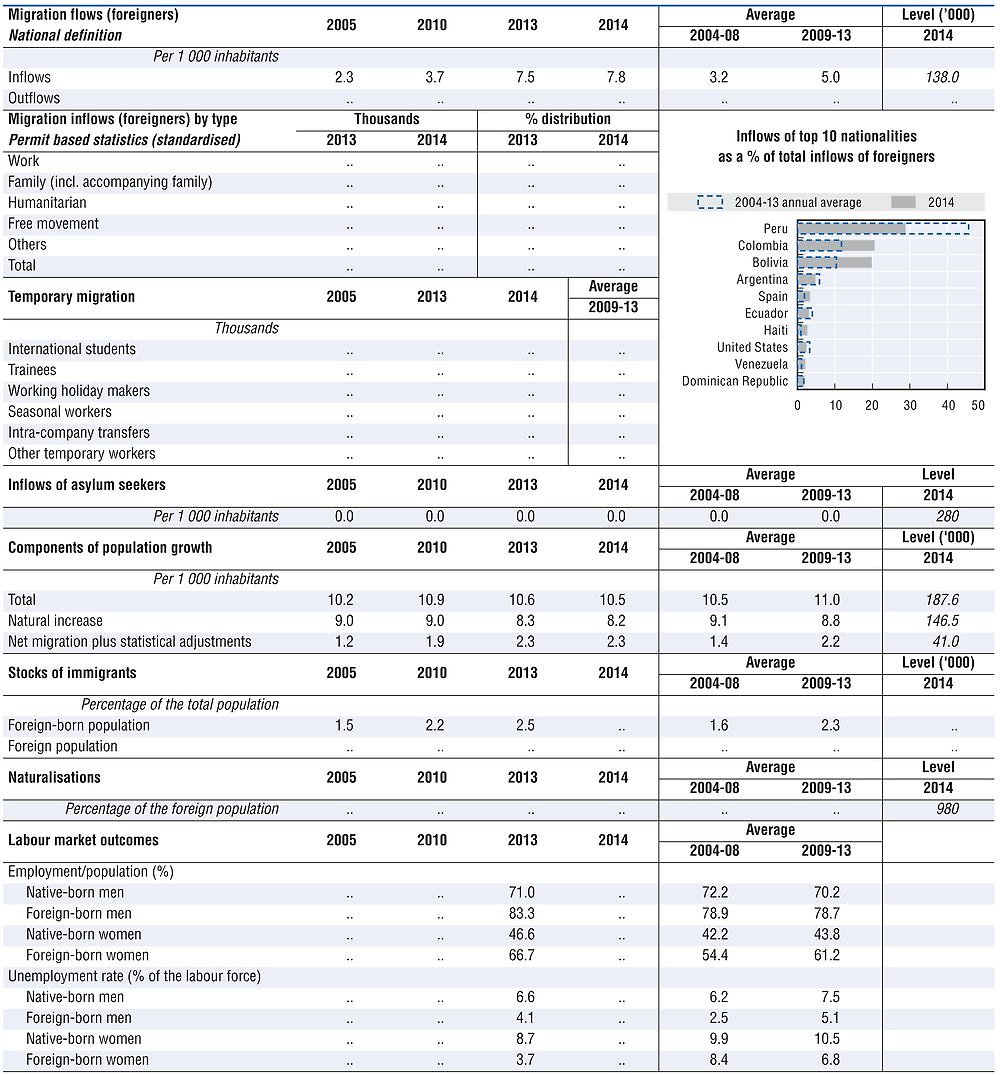Chile
According to the Ministry of the Interior and Public Security, close to 411 000 foreign nationals were living in Chile in 2014, accounting for 2.3% of the total population. Three-quarters were nationals of other South American countries. Nationals of European and North American countries together represented 17% that year, versus 24% in 2005.
The leading source countries of foreign residents were Peru (32% in 2014), Argentina (16%), Bolivia (9%), Colombia (6%) and Ecuador (5%); Spain (4%), the United States (3%) and China (2%) were the main source countries of residents not from South America. The foreign resident population is concentrated in the cities of Santiago and Arica, as well as in the mining regions of Tarapacá, Antofagasta and Atacama, where the share of foreign population has almost doubled since the mid-2000s.
In 2014, the number of permanent residence permits delivered rose by 39% to reach 39 000 after a 5% decrease in 2013. Holders of a permanent residence permit were primarily Peruvian (accounting for 28%), Bolivian (21%), Colombian (16%), and Argentinian and Spanish nationals (5% each). Compared to 2005, the number of permanent permits issued to Peruvians and Argentinians declined while the issuance to Bolivians, Colombians and Spaniards increased. Grants of permanent residency to Dominican and Haitian nationals were negligible in 2005 but represented 3% and 2% respectively of the permanent flow in 2014.
The number of newly issued visas more than tripled between 2005 and 2014, from 41 400 to 137 400. After one to two years under the visa regime (or after completion of studies), immigrants can apply for permanent residence. Approximately half of the visas were issued to foreigners based on an employment contract (66 600) in 2014. While Peruvian nationals were still the largest group of visa recipients (44% of employment contracts in 2014), the numbers of visas issued to the second group (Colombian nationals) and to the third group (Haitian nationals) were higher than in previous years. They accounted for 32% and 4% of the flows, respectively.
The other half newly issued visas were mainly temporary (68 500). There are several types of visas in this growing category, such as those granted to professionals and technicians; to relatives of Chileans or of permanent residents; and to nationals of a number of other South American countries that are signatories to the Southern Common Market (MERCOSUR) Residence Agreement. In 2012, immigrants given special visas accorded to nationals of Mercosur represented 16% of the total annual inflows. Their share is likely to grow, blurring the relevance of the other visa categories as recipients can include workers, students or family migrants. More often than in the past decade, these migrants are heading to the northern regions, especially Antofagasta, while the trend in migration flows to the metropolitan and southern regions is declining. In 2014, the main source countries of migrants residing under this title are Bolivia – which benefits from the MERCOSUR Residence Agreement visas since 2010 (40%, versus 4% in 2005), Peru (15%), Colombia (10%) and Argentina (9%).
Student visas accounted for only 2% (2 300) of all newly issued visas, with Colombia, Peru, Ecuador and the United States the main origin countries.
In 2014, Chile received 280 asylum applications. Colombian nationals accounted for the vast majority of applications.
The year 2015 saw major changes in the Chilean migration regime. First, the procedure for applying for residence in the Antofagasta region – which attracts a growing number of temporary immigrants, mainly originating from Bolivia – was eased in January. Second, a new visa category (visa de unión civil) was created to allow foreigners who married a Chilean abroad and those who celebrated an agreement of civil union, either in Chile or abroad, to reside and work in Chile. A new labour-based visa (visa por motivos laborales) was also introduced. Third, an agreement was reached to offer better access to health services to vulnerable immigrants. Finally, in order to better comply with international laws, children under the age of 14 are now exempted from migration penalty.
In April 2016, a new agreement was signed between Chile and Hungary on the exchange of Working Holiday makers. This followed an earlier agreement with New Zealand in 2001.

